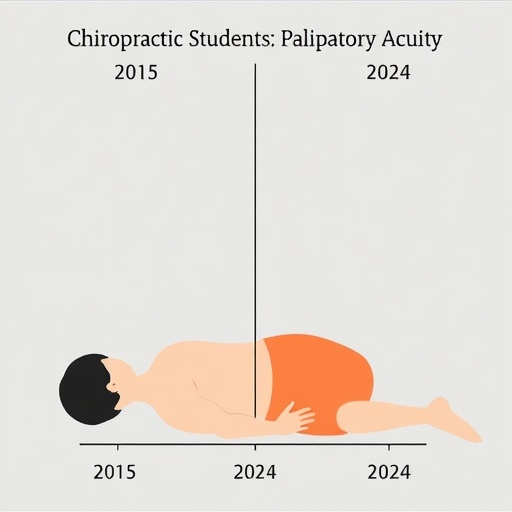In a groundbreaking study published in BMC Medical Education, researchers Cade, Stevens, and Duehr examined the evolution of palpatory acuity in chiropractic students over a nine-year period, from 2015 to 2024. This comparative analysis highlights significant shifts in skills that could have profound implications for chiropractic education and patient care practices. By scrutinizing the tactile sensitivity of students across multiple cohorts, the team aimed to understand how educational practices and curriculum changes may impact clinical skills—specifically the ability to detect subtle physiological changes through touch.
The hallmark of chiropractic care lies in the practitioner’s ability to feel and interpret biomechanical and physiological states within the body. Palpatory acuity refers to the sensitivity and accuracy with which practitioners assess physical conditions by touch. This study is particularly pertinent as it reflects the changing landscape of chiropractic training, which has been increasingly influenced by advances in technology, heightened patient expectations, and evolving healthcare paradigms.
To conduct this investigation, the researchers implemented a carefully designed methodology. A series of assessments were administered to chiropractic students from different cohorts, focusing on their ability to accurately identify specified anatomical landmarks and physiological conditions through palpation. By testing students’ sensitivities, the researchers sought to identify trends in proficiency that could either be attributed to advancements in educational techniques, changes in patient demographics, or modifications in curricular content.
The results were illuminating. The analysis revealed a notable increase in palpatory acuity among students who underwent training during the latter periods of the study. This suggests that newer educational techniques—potentially integrating digital simulations, enhanced feedback mechanisms, and interdisciplinary learning methods—are significantly bolstering the tactile skills of practitioners entering the field. The incorporation of newer pedagogical approaches that emphasize experiential learning may account for these marked improvements.
Moreover, as the chiropractic field continues to evolve with the integration of evidence-based practices, this research underscores the necessity for academic institutions to adapt their curricula. Emphasizing skills such as palpatory acuity is essential, especially as patients seek more holistic health solutions. The findings may indicate a shift towards deeper engagement with tactile skills during chiropractic training, essential for future practitioners who aim to provide comprehensive care.
Additionally, the analysis also suggests potential external factors influencing this trend. The researchers noted a growing awareness among students regarding the importance of palpation in clinical evaluations. Increased accessibility to resources, such as video tutorials and peer-learning networks, could enhance a student’s ability to hone their skills outside traditional classroom settings. Also, diverse clinical exposures during internships might have offered students broader opportunities to practice palpation under various circumstances.
However, it is essential to recognize the limitations of the study. While the authors have taken great care to ensure a robust methodological approach, the research is primarily limited by the specific demographic and geographic scope of the student populations analyzed. This raises questions about whether the observed trends in palpatory acuity can be generalized across all chiropractic schools and geographic regions. Future research may be necessary to confirm findings within a broader context.
A key takeaway from the study is the importance of maintaining high education standards in chiropractic training. With ongoing improvements in technology and teaching methodologies, it is crucial for academic institutions to continually assess and adjust their curricula to ensure students are well-prepared for real-world challenges in patient care. The findings from this study serve as a powerful reminder of the interdependence between educational practices and clinical outcomes in healthcare professions.
Furthermore, this research challenges the chiropractic community to reconsider how palpatory acuity will be viewed as a core competency in light of evolving healthcare delivery models. With patients becoming more educated and engaged in their own health care, there is an expectation for practitioners to possess not only technical skills but also an acute understanding of human anatomy and physiological interactions.
In conclusion, Cade, Stevens, and Duehr’s comparative analysis sheds light on a vital aspect of chiropractic education. By gauging palpatory acuity across different cohorts of students, the researchers underscore the importance of a hands-on approach in developing essential clinical skills. As the global healthcare landscape continues to evolve, the study serves as a timely reminder of the need for adaptive educational strategies that equip future practitioners with the skills necessary to thrive in their professions and provide exemplary patient care.
This comparative study not only reflects the advancements in educational practices over time but also serves as a call to action for educators to continually integrate feedback and adaptation into their training methods to better serve future generations of healthcare providers and their patients.
Subject of Research: Palpatory acuity in chiropractic education over time
Article Title: A comparative analysis of palpatory acuity in chiropractic students between 2015 and 2024
Article References:
Cade, A., Stevens, K., Duehr, J. et al. A comparative analysis of palpatory acuity in chiropractic students between 2015 and 2024.
BMC Med Educ 25, 1469 (2025). https://doi.org/10.1186/s12909-025-08073-y
Image Credits: AI Generated
DOI:
Keywords: palpatory acuity, chiropractic education, clinical skills, experiential learning, chiropractic training, educational methods, healthcare evolution




